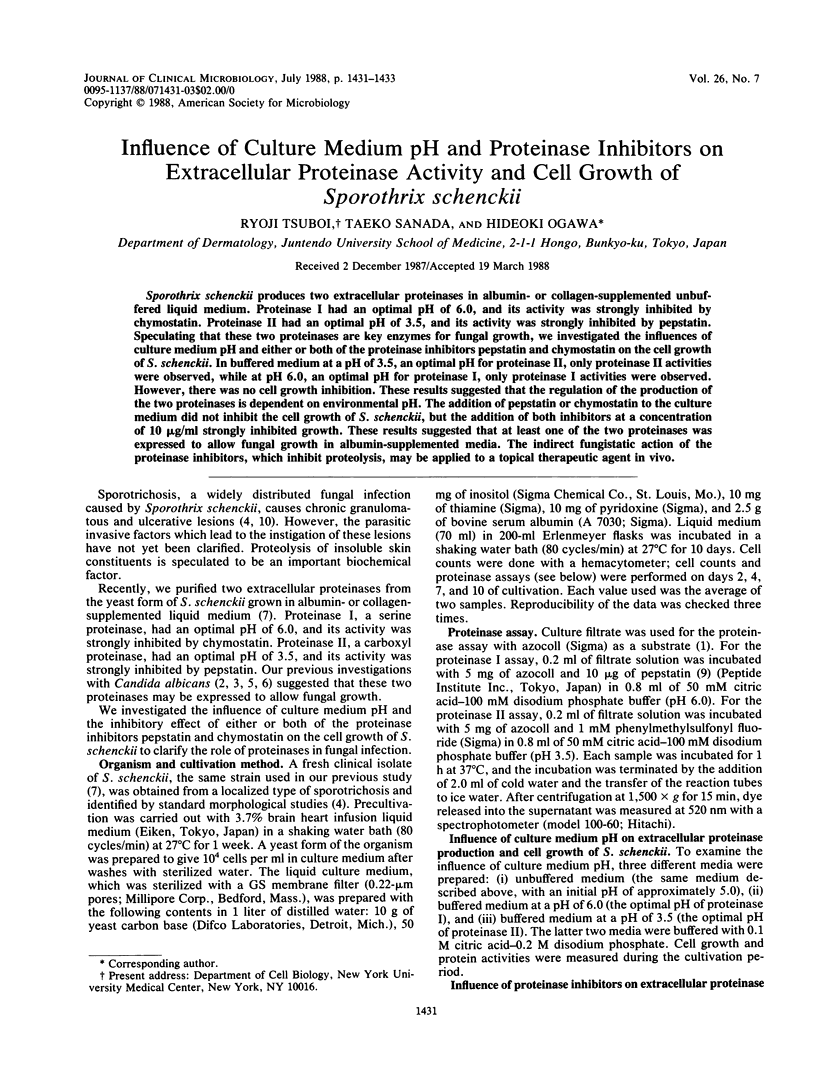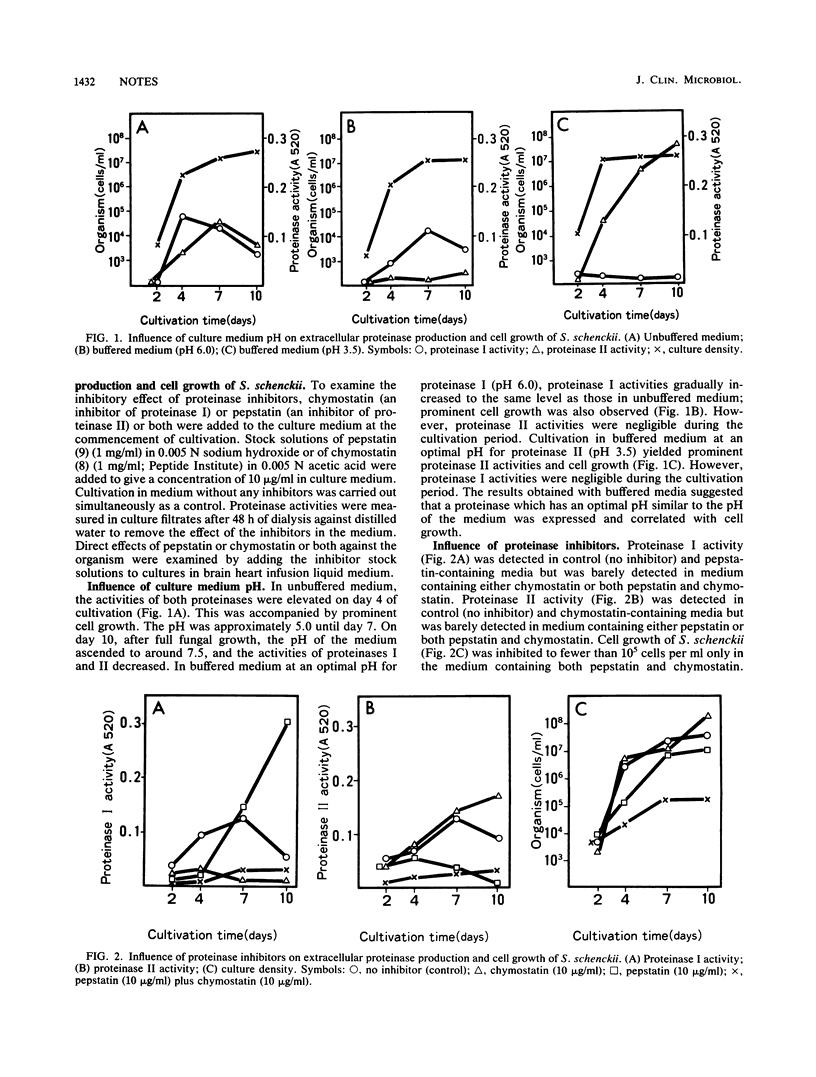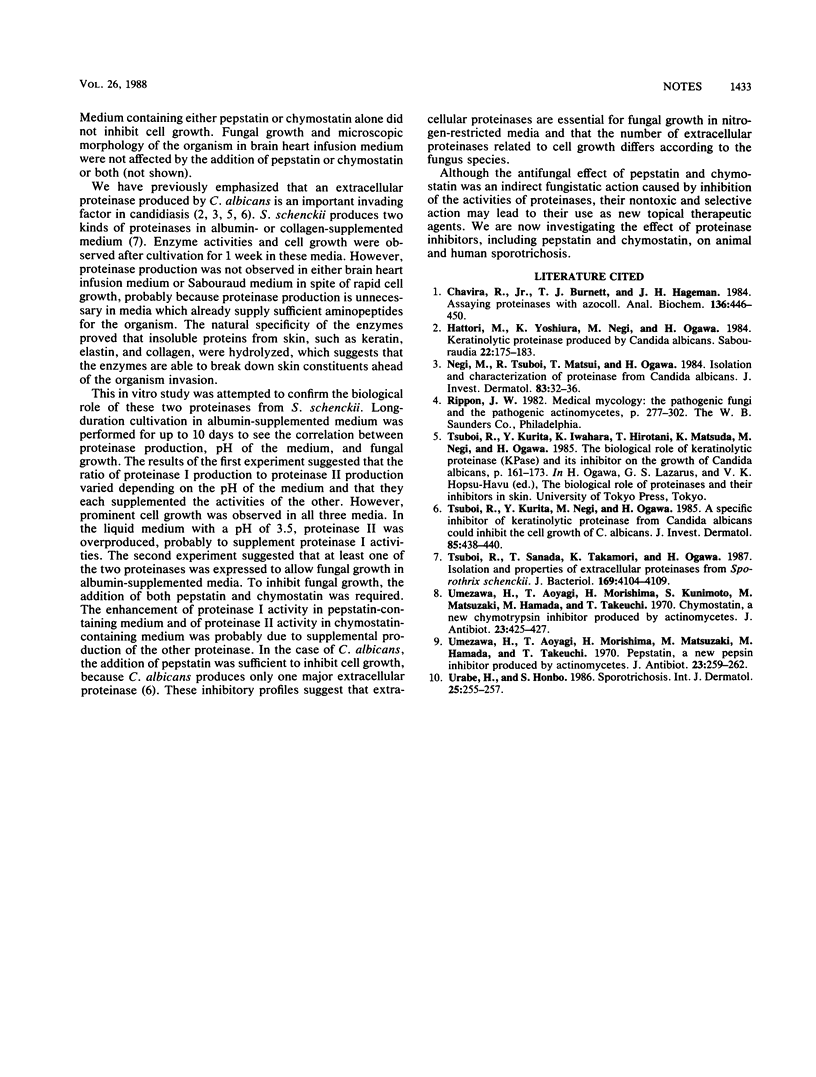Abstract
Sporothrix schenckii produces two extracellular proteinases in albumin- or collagen-supplemented unbuffered liquid medium. Proteinase I had an optimal pH of 6.0, and its activity was strongly inhibited by chymostatin. Proteinase II had an optimal pH of 3.5, and its activity was strongly inhibited by pepstatin. Speculating that these two proteinases are key enzymes for fungal growth, we investigated the influences of culture medium pH and either or both of the proteinase inhibitors pepstatin and chymostatin on the cell growth of S. schenckii. In buffered medium at a pH of 3.5, an optimal pH for proteinase II, only proteinase II activities were observed, while at pH 6.0, an optimal pH for proteinase I, only proteinase I activities were observed. However, there was no cell growth inhibition. These results suggested that the regulation of the production of the two proteinases is dependent on environmental pH. The addition of pepstatin or chymostatin to the culture medium did not inhibit the cell growth of S. schenckii, but the addition of both inhibitors at a concentration of 10 micrograms/ml strongly inhibited growth. These results suggested that at least one of the two proteinases was expressed to allow fungal growth in albumin-supplemented media. The indirect fungistatic action of the proteinase inhibitors, which inhibit proteolysis, may be applied to a topical therapeutic agent in vivo.
Full text
PDF


Selected References
These references are in PubMed. This may not be the complete list of references from this article.
- Chavira R., Jr, Burnett T. J., Hageman J. H. Assaying proteinases with azocoll. Anal Biochem. 1984 Feb;136(2):446–450. doi: 10.1016/0003-2697(84)90242-2. [DOI] [PubMed] [Google Scholar]
- Hattori M., Yoshiura K., Negi M., Ogawa H. Keratinolytic proteinase produced by Candida albicans. Sabouraudia. 1984;22(3):175–183. [PubMed] [Google Scholar]
- Negi M., Tsuboi R., Matsui T., Ogawa H. Isolation and characterization of proteinase from Candida albicans: substrate specificity. J Invest Dermatol. 1984 Jul;83(1):32–36. doi: 10.1111/1523-1747.ep12261656. [DOI] [PubMed] [Google Scholar]
- Tsuboi R., Sanada T., Takamori K., Ogawa H. Isolation and properties of extracellular proteinases from Sporothrix schenckii. J Bacteriol. 1987 Sep;169(9):4104–4109. doi: 10.1128/jb.169.9.4104-4109.1987. [DOI] [PMC free article] [PubMed] [Google Scholar]
- Tsuobi R., Kurita Y., Negi M., Ogawa H. A specific inhibitor of keratinolytic proteinase from Candida albicans could inhibit the cell growth of C. albicans. J Invest Dermatol. 1985 Nov;85(5):438–440. doi: 10.1111/1523-1747.ep12277147. [DOI] [PubMed] [Google Scholar]
- Umezawa H., Aoyagi T., Morishima H., Kunimoto S., Matsuzaki M. Chymostatin, a new chymotrypsin inhibitor produced by actinomycetes. J Antibiot (Tokyo) 1970 Aug;23(8):425–427. doi: 10.7164/antibiotics.23.425. [DOI] [PubMed] [Google Scholar]
- Umezawa H., Aoyagi T., Morishima H., Matsuzaki M., Hamada M. Pepstatin, a new pepsin inhibitor produced by Actinomycetes. J Antibiot (Tokyo) 1970 May;23(5):259–262. doi: 10.7164/antibiotics.23.259. [DOI] [PubMed] [Google Scholar]
- Urabe H., Honbo S. Sporotrichosis. Int J Dermatol. 1986 May;25(4):255–257. doi: 10.1111/j.1365-4362.1986.tb02238.x. [DOI] [PubMed] [Google Scholar]


